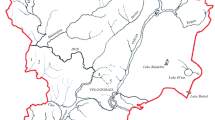Abstract
Deterioration of the phytosanitary state of the soil and crops that occurred in the course of intensive agricultural development of chestnut soils has been revealed. Stationary observations were carried out at the Kachalino experimental-production farm of the Federal Research Center of Agroecology of the Russian Academy of Sciences located in the Ilovlya district and at the Gornaya Polyana experimental-production farm located in the Volgograd region. The analysis of winter wheat plants has revealed the presence of such root rot pathogens as Alternaria alternariae (Cooke) Woudenb. & Crous., Fusarium oxysporum Schlecht, and Bipolaris sorokiniana Shoemaker. A positive effect of protective afforestations on the phytosanitary condition of cereal crops has been determined. During the infection spreading period in April, tree species used in protective afforestations provided a different influence on the wind speed and soil moisture of the adjacent territories. Elm and oak forest belts effectively reduce a root rot occurrence in winter wheat; their biological efficiency makes 13.71‒43.96%. The root rot development in protected zones (up to 150 m from trees) was reduced by 5‒7%, while the yield increased by 9.4‒21.3%.


Similar content being viewed by others
REFERENCES
Boulanger, Y., Taylor, A.R., Price, D.T., Cyr, D., McGarrigle, E., Rammer, W., Sainte-Marie, G., Beaudoin, A., Guindon, L., and Mansuy, N., Climate change impacts on forest landscapes along the Canadian southern boreal forest transition zone, Landscape Ecol., 2016, vol. 32, pp. 1415–1431.
Cherkashin, V.N., Cherkashin, G.V., and Kolomytseva, V.A., Phytosanitary problems in the development of no-till technology in the Stavropol Territory, Agrarnaya Nauka, 2020, no. 10, pp. 77–82.
Dospekhov, B.A., Metodika polevogo opyta (s osnovami statisticheskoi obrabotki rezul’tatov issledovanii) (Field Experience Methodology (with the Basics of Statistical Processing of Research Results), Moscow: Agropromizdat, 1985, 5th ed.
Kretinin, V.M. and Koshelev, A.V., Problems of agroforestry in Volgograd Oblast, Izvestiya Nizhnevolzhskogo Agrouniversitetskogo Kompleksa: Nauka i Vysshee Professional’noe Obrazovanie, 2017, no. 3 (47), pp. 73–78.
Kryukova, E.A. and Kolmukidi S.V., Influence of protective forest plantation parameters on the pathological condition of phytocenoses of the forest-agrarian landscapes, Izvestiya Orenburgskogo Gosudarstvennogo Agrarnogo Universiteta, 2015, no. 6 (56), pp. 47–50.
Kulikov, I.M., About the social agrarian structure rationalization: The look through the prism of property relations, Vestnik Instituta Ekonomiki Rossiiskoi Akademii Nauk, 2014, no. 6, pp. 51–64.
Kulik, K.N. and Koshelev, A.V., The methodical basis of the agroforest reclamation assesment of protective forest plantations by the data of remote monitoring, Lesotekhnicheskii Zhurnal, 2017, vol. 7, no. 3 (27), pp. 107–114.
Podkovyrov, I.Y., Kimsanbaev, O.H., Zhemchuzhina, N.S., Ermak, D.Y., Ilyusinova, L.S., and Nasonova, T.V., The emergence and development of mycoses in short-day plants under conditions of long day light hours, E3SWeb of Conferences, 2020, vol. 203, p. 02009.
Podkovyrov, I.Yu., Adaptive potential of the genus Ulmus L. species in agro-urban systems, Plodovodstvo i Yagodovodstvo Rossii, 2015, vol. 42, pp. 351–354.
Rulev, A.S. and Pugacheva, A.M., Formation of a new agroforestry paradigm, Her. Russ. Acad. Sci., 2019, vol. 89, no. 5, pp. 495–501.
Sanin, S.S., Phytosanitary problems of Russia at the present stage, Zashchita i Karantin Rastenii, 2016, no. 4, pp. 3–6.
Sanin, S.S., Plant protection and sustainable agriculture in the XXI century, Zashchita i Karantin Rastenii, 2020, no. 4, pp. 9–16.
Semenov, A.M., Glinushkin, A.P., and Sokolov, M.S., Organic agriculture and health of soil system, Dostizh. Nauki Tekh. APK, 2016, vol. 30, no. 8, pp. 5–8.
Sokolov, M.S., Sanin, S.S., Dolzhenko, V.I., Spiridonov, Yu.Ya., Glinushkin, A.P., Karakotov, S.D., and Nadykta, V.D., The concept of fundamental-applied studies of plant and yield protection, Agrokhimiya, 2017, no. 4, pp. 3–9.
Zakharenko, V.A., Food program of Russia and phytosanitary safety of agro-ecosystems, Zashchita i Karantin Rastenii, 2011, no. 9, pp. 7–9.
Zakharenko, V.A., Assessment of the phytosanitary potential in grain production in Russia, Zashchita i Karantin Rastenii, 2013, no. 10, pp. 3–7.
Funding
The study was carried out within the framework of the State Assignment of the Federal Research Center of Agroecology, Integrated Land Reclamation, and Protective Afforestation (theme no. FNFE-2022-0007 Theory and principles of a formation of adaptive land-reclamation complexes of dry steppe zones in southern Russia in the context of climatic changes).
Author information
Authors and Affiliations
Corresponding author
Ethics declarations
Conflict of interests. The authors declare that they have no conflict of interest.
Statement on the welfare of animals. This article does not contain any studies involving animals performed by any of the authors.
Additional information
Translated by N. Statsyuk.
Rights and permissions
About this article
Cite this article
Sytin, G.O., Podkovyrov, I.Y. The Effect of Protective Afforestation on the Phytosanitary State of Chestnut Soils. Arid Ecosyst 13, 73–78 (2023). https://doi.org/10.1134/S2079096123010146
Received:
Revised:
Accepted:
Published:
Issue Date:
DOI: https://doi.org/10.1134/S2079096123010146



